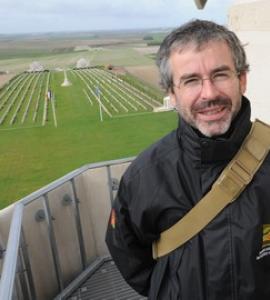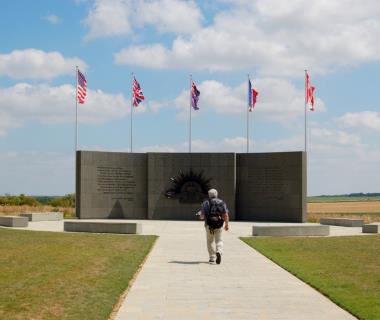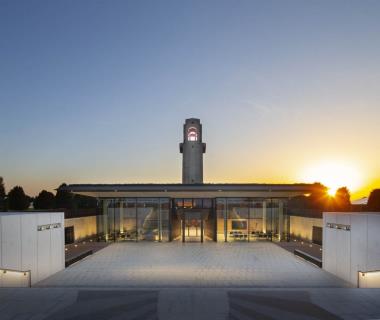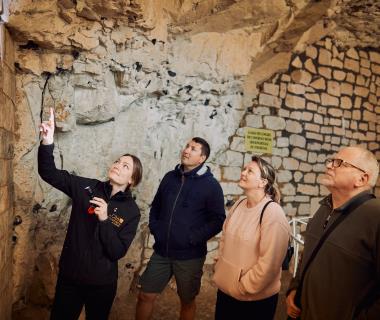In the Diggers' footsteps
- 5remembrance sites
- 403thousand Australian and New Zealand soldiers
- 10762names
The Australian war effort
in the Somme
While fighting in the Somme, the former gold-diggers from Down Under were nicknamed the Diggers.
Like other countries, Australia immediately came to the support of the British Empire at the outbreak of war in August 1914.
25 April, known as ANZAC Day, is the national Remembrance day in Australia and New Zealand. The ceremony pays homage to the men who fought and gave their lives during the war.
The Australian Remembrance Trail along the Western Front serves to help Australians and others visitors learn more about Australia's commitment on the Western Front between 1916 and 1918 in France and in the Somme.
 ©Nicolas Bryant
©Nicolas Bryant © Garry
© Garry ©Nicolas Bryant
©Nicolas Bryant
The Diggers
in Pozières
Pozières was the key obstacle which had to be overcome in order to capture first Mouquet Farm and then Thiepval Ridge. On 23 July 1916, they launched an attack on Pozières, where one in three soldiers were killed.
In all, 23,000 were killed, wounded or MIA : these were among the heaviest losses in Australian military history.
Today, the village pays homage to them with several monuments and sites dedicated to Australia's commitment : the Mouquet farm, the Tanks Corps Memorial, the Windmill site, the 1st Australian Division Memorial, the Gibraltar blockhouse...
The Digger Cote 160 Association, based in Pozières, aims to promote relations between Australia and the small French village to work for the memory of the soldiers who fought there.
Every second year in July, the Digger Cote 160 Association organises a great historical sound and light display about life in the village of Pozières during the Battle of the Somme in 1916.
 ©Garry
©Garry ©Ronan Le Bideau
©Ronan Le Bideau Aurelien Roger
Aurelien Roger
Tribute to the Diggers
Villers-Bretonneux, Le Hamel
ANZAC forces finally halted the German offensive of March 1918 in Villers-Bretonneux with fighting on 24, 25 and 26 April 1918.
Now, the Australian National Memorial at Villers-Bretonneux affords a wide panorama of the surrounding countryside. It was one of the last memorials to the Great War to be erected in France.
The Australian Memorial in Le Hamel pays tribute to the famous tactical attack on 4 July 1918, when General Monash notoriously reached all his objectives in a mere 93 minutes ! There are several plaques to commemorate his achievements throughout the town.
Australian troops took part in other battles on the Somme front in 1918.
On 2 September 1918, the Australians liberated Péronne, also capturing the strategic point Mont Saint-Quentin. This was hailed as one of the greatest Australian victories during the war. Their exploits are explained in full during a walk with full commentary.

Keeping the legacy
of the soldiers alive
Set on the grounds of the Australian National Memorial and adjacent to the Villers-Bretonneux military cemetery in Northern France, the Sir John Monash Centre is one of the key sites of the Australian Remembrance Trail along the Western Front.
This cutting-edge multimedia centre reveals the Australian Western Front experience through a series of interactive multimedia installations and immersive experiences. The SJMC App, downloaded onto each visitor's personal mobile device, acts as a 'virtual tour guide' and helps visitors gain a better understanding of the journey of ordinary Diggers.
Entirely renovated in 2016 and located on the first floor of Victoria School in Villers-Bretonneux, the Franco-Australian Museum is themed not only on the story of an international friendship that developed through war and hardship, but also on remembrance and hope for the future.
The museum layout enables visitors to fully comprehend how this friendship between the two countries was formed. The message of thanks displayed in the schoolyard, which reads "Do not forget Australia", has to be highlighted.

Let's talk ToOlivier DIRSON
Independent guide, "Chemins d'Histoire"
Useful information
in the Diggers' footsteps
- Val de Somme Tourist Office
28/30 place de la République - 80800 Corbie
Tél +33 (0)3 22 96 95 76
officedetourisme@valdesomme.com
valdesomme-tourisme.com
- The Sir John Monash Centre
Route de Villers Bretonneux - 80800 Fouilloy
Tél +33 (0)3 60 62 01 40
info@sjmc.gov.au
sjmc.gov.au
- The Franco-Australian Museum
9, rue Victoria - 80800 Villers-Bretonneux
Tél +33 (0)3 22 96 80 79
museeaustralien@gmail.com
museeaustralien.com
Can't-miss places
in the Diggers' footsteps
- Go to the Australian National Memorial at Villers-Bretonneux and visit the Sir John Monash Centre.
- Take part in the moving ANZAC Day Ceremony on April 25 at 5.30am at Villers-Bretonneux.
- Immerse yourself in the village of Pozières, where Australia's commitment in the Somme began.
- Take a trip back in time at the Australian Corps Memorial at Le Hamel, well-known for the 93 minutes battle.
- Follow in the footsteps of the Diggers at Mont Saint-Quentin to see the 2nd Australian Division Memorial.
- Discover the brand-new Vignacourt14-18, where a French couple of farmers began taking photographs of Australian soldiers.
- Descend 30 metres beneath the ground and visit the Underground City of Naours, where more than 3,000 WW1 graffitis have been discovered.
The Diggers
behind the lines
- During the Great War, Vignacourt was used for French and Allied logistics. The Underground City of Naours was visited by soldiers during their time behind the lines. Today, this shows the life behind the lines.
- Vignacourt14-18 welcomes you to the Thuillier’s renovated farmhouse which is devoted to their photograph collection. This exhibition tells the story of life behind the lines.
- During the Great War, the Underground City of Naours was used as an organised tour destination : a means of distraction for soldiers on leave or convalescent behind the front lines.
Join us on Instagram !Somme1914_1918
 ACarrier
ACarrierWant to see the main sites of remembrance in the Somme ? Museums, memorials, battlefields and other sites to discover here !
Join the official account on Instagram : Somme1914_1918
Follow us on Facebook !Great War Centenary in the Somme

Want to know everything about the Somme Battlefields (events, sites, commemorations...) ? Follow the official page of the remembrance tourism in the Somme !
Follow us on Facebook : Great War in the Somme
En Direct des blogs Tortuga Videos
 Mathis BEHAEGEL - LA TORTUGA
Mathis BEHAEGEL - LA TORTUGAA velo sur les traces de la bataille de la Somme !
C’est accompagné de son vélo Franklin, que Mathis Behaegel, alias "La Tortuga", a emprunté la véloroute Vallée de Somme pour partir la découverte de l'est du territoire et l'histoire de la Bataille de la Somme. Au programme : Des paysages marqués par le conflit mondial, des rencontres avec des passionnés, des mémoriaux emblématiques de la destination et de la nature.
A découvrir en vidéo ET en podcast !
Pour visionner la vidéo, cliquez ici !
You'll like too
Remembrance sites
Mémorial Australien de Le Hamel
Museums and places of interest
Centre Sir John Monash
Archaeology, cave



